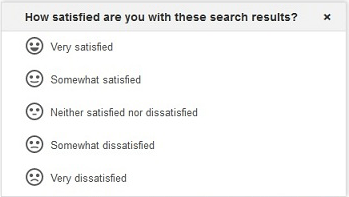
What is dwell time? In this blog post, I’m going to provide a clear definition of it, explain why it matters in SEO, and show you how to increase it.
A definition of dwell time
Dwell time is the amount of time between the moment a user clicks on a search result and the moment they return to the search engine results pages (‘SERPs’).
Dwell time matters in search engine optimization (SEO) because it has the potential to tell a search engine how useful a page is to a user.
If a user clicks through to a web page from search results, but after a quick look at it clicks the back button on their web browser, this suggests that the page isn’t giving them the information they need.
But if that user stays on that page for a long period of time before returning to the search results, or doesn’t return to the search results at all, they’re sending a signal to search engines that the page IS satisfying their query.
Search engines can then use that signal to decide whether or not to show that web page for similar search queries in future.
Do search engines actually use dwell time to rank pages?
Well, based on information posted on the Microsoft blog, we know that it’s fairly likely that Bing does.
As for Google, the company is less clear on the subject.
One the one hand, Google engineers have suggested that its machine learning algorithms consider dwell time when ranking content.
And Google has been observed asking people for feedback on search results when they quickly return to the SERPs after clicking on a particular result (see screenshot below).

But Google’s Search Advocate John Mueller is on record as saying that the time spent on a page isn’t a ranking factor.
Time on page isn’t necessarily the same as dwell time, however; dwell time refers specifically to how long a user spends on a page before returning to the search results.
As for third-party studies into dwell time, research by the SEO site Moz indicates there may be a correlation between dwell time and better Google rankings.
Furthermore, Google has registered a ‘long click’ patent that suggests dwell time might be a ranking factor.
And when I attended a Google Search Central Live event in Zurich recently, I was interested to hear Daniel Waisberg (a Search Advocate at the company) talking about what an ‘engaged visit’ to a site constituted — a 10 second or longer stay on the site (as measured by Google Analytics).
Now of course that doesn’t necessarily mean an engaged visit is rewarded with higher rankings — but I’d be surprised if Google wasn’t doing something with this data.
As with much else in search engine optimization, the waters are a bit muddy!
But there definitely is some evidence to suggest that dwell time is a ranking factor, and accordingly, it’s something worth focusing on in your SEO work.
(And at the very least, if you create pages that engage people for a long period of time, you’ll quite possibly be creating helpful content — something that Google rewards in search results anyway!).
How do I measure dwell time?
Well in truth, you can’t, because you’re not a search engine. But you can get a rough idea of a page’s dwell time by looking at its ‘average session duration time‘ metric in Google Analytics.
I say ‘rough idea’ because this metric doesn’t just show you the length of time somebody spent on a landing page before hitting the back button — it covers quite a few other scenarios too.
Accordingly, it should be used as more of an indication of how engaging content is, rather than a precise calculation of dwell time.
But how can you actually increase dwell time?
Let’s take a look at doing just that.
Ways to increase dwell time
Before discussing specific tactics for keeping people longer on your web pages, it has to be said that the best way to increase dwell time is simply to make your content as engaging and as interesting as it can possibly be to your users — and as relevant to the search queries they’re using.
If a piece of content is genuinely satisfying to a user, this will naturally lead to an increase in session duration.
But that said, there are some specific tactics you can use to keep people on your web pages longer.
Let’s go through these now.
1. Embed videos in your site content
By adding videos to your content and encouraging your visitors to watch them, you can keep people on your pages longer — in some cases, considerably longer.
Similarly, compelling images, charts and infographics can also help keep readers interested and increase the average time they spend reading a page or post.
💡 Tip: Even if you don’t have any videos of your own to enhance your pages and posts with, you can still apply this tactic — just embed somebody else’s YouTube videos in your content!
Make sure that any videos you add to your content are relevant to it, however (and high-quality in nature). And don’t add too many videos — you don’t want to overwhelm your users, make your page load slowly, or appear spammy to Google.
2. Lengthen your content
Although creating ‘long form content’ for the sake of it should be avoided, it’s fair to say that quality, in-depth articles with large word counts can definitely increase the amount of time your visitors spend on your content — and by extension, the average dwell time.
The emphasis has to be creating on quality content, though: ‘bloat’ or ‘fluff’ will not be liked by users — or rewarded by search engines.
3. Encourage comments on your content
A lot of website visitors love to read and react to user comments, so if there’s a lot of comments on your content, you’ll probably keep people hanging around for longer on it.
So actively encourage your visitors to add comments or questions to your posts: it will naturally lengthen your content and make it more engaging.
As always, the emphasis has to be placed on quality here: moderate the comment approval process carefully, and only publish relevant, interesting comments.
Any questions on this? Leave a comment 🙂
4. Ensure your pages load quickly
There’s a lot of research available that shows that if a web page loads slowly, it is much more likely to be abandoned, with users returning to search results very quickly.
This is obviously going to result in a poor dwell time — so make sure that you do as much as you can to improve your site’s page speed.
5. Make your content really easy to understand
If your website’s content is confusing or full of jargon, you’re going to annoy your visitors and have them heading straight for the back button on their browser.
So when writing for the web, always:
- use simple language
- break your content into clear sections
- use headings to separate out key topics and concepts
- use short paragraphs.
Similarly, you should avoid creating a poor user experience: pop ups, slow-loading images and intrusive ads on a piece of content can lead to readers making a swift exit from your site.
6. Use bucket brigades to keep users reading
Using ‘bucket brigades’ is a copywriting tactic that encourages visitors to stick around to find out what happens next.
Bucket brigades tend to be questions or sentences that end in colons, for example:
- What’s the best way to do this?
- Now, think about this:
- Here’s the story:
- It gets worse…
- But here’s why it matters:
The trick is to insert bucket brigades into sections of your content where you think people might be losing interest — a good bucket brigade can pique it again.
So that’s it — our simple guide to dwell time and how to increase it! Good luck with encouraging your site visitors to spend more quality time with your content.
For more SEO resources, make sure you download the free Style Factory SEO kit below – this contains a host of downloadable SEO cheatsheets and extended free trials of SEO tools.
Don’t miss out on our free SEO toolkit
For a limited time only we’re offering our readers some excellent free SEO tools and resources. Sign up now to immediately receive:
- our downloadable cheatsheet containing the 20 key steps to ranking highly in search results
- extended free trials and discounts for leading SEO tools
- our downloadable cheatsheet on how to grow organic traffic to a blog
- 2 in-depth guides to SEO
- ongoing free tips and advice on SEO and growing your business
And to get other quick tips on SEO, digital marketing and ecommerce, don’t forget to subscribe to our YouTube channel and hit the notifications bell.
Finally, if you have any questions about dwell time, just pop them in the comments section below. We read them all and will do our best to help.
No comments